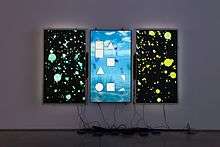Tabor Robak
Tabor Robak (born May 31, 1986) is an American artist, working in New Media.

Early life and education
Tabor Robak was born in Portland, Oregon. He graduated with a BFA from the Pacific Northwest College of Art in 2010, after which he moved to Brooklyn, New York.[1]
Early in his career, Robak worked as a graphic designer for companies such as Nike and T-Mobile.[2]
Career and work
Tabor Robak's early works consisted of 3D interactive environments, to be accessed on the artist's website.[3] These pieces, which the artist described as having a "desktop screensaver aesthetic,"[4] sought to isolate digital space as a fact, an abstracted, alternate reality. Robak's work explore the visual vocabulary of modern video games, advertising and animated film, to examine societal perceptions of the digital and the real.[5][6]

Robak has had several solo exhibitions at Team Gallery: Next-Gen Open Beta (2014), Fake Shrimp (2015), Sunflower Seed (2016) and Quantaspectra (2017).[7] He has had one solo exhibition at Johan Berggren Gallery: Sunflower Seed (2016).[8]
Critical reception
The New York Observer called the exhibition "one of the major events of the season" both because of the quality of the work and because it was "signaling [digital art's] newfound acceptance by big-league galleries like Team."[5] Roberta Smith reviewed the exhibition in The New York Times, praising Robak's virtuosity, his dazzling visuality, and "his meshing of high and low; digital and labor-intensive; art and advertising."[9]
Artistic process
Tabor Robak employs several programs to create his artworks, including Unity, Adobe After Effects, and Cinema 4D.[10] His early work was primarily looped video. He has used novel technology, including transparent television monitors and miniature Raspberry Pi computers. Since 2016, Robak's output has shifted from looped video to the production of so-called "generative artworks," which create their imagery via dedicated, custom-built computers.[11]
Major commissions and museum collections
In 2017, Robak was commissioned by Microsoft to an artwork for the 40-foot screen on the facade of their flagship store on 5th Avenue.[12] Robak's works have been acquired by a number of major museums, including The Museum of Modern Art,[13] The Metropolitan Museum of Art,[14] and Albright-Knox Art Gallery.[15]
References
- "See mesmerizing works from digital artist Tabor Robak". Time Out New York. Retrieved 2017-06-17.
- "Tabor Robak - Biography, Exhibitions, and Art on ARTUNER". ARTUNER | Curated Contemporary Art for Sale. Retrieved 2017-06-17.
- "Artist Profile: Tabor Robak". Rhizome. Retrieved 2017-06-17.
- "Explore The Sublime Visual World Of Tabor Robak's Video Game For Gatekeeper's Exo". Creators. Retrieved 2017-06-17.
- "'Tabor Robak: Next-Gen Beta' at Team Gallery". Observer. 2013-12-03. Retrieved 2017-06-17.
- "Can Digital Artist Tabor Robak Become Pixelangelo?". Vulture. Retrieved 2017-06-17.
- "Artist CV on Team Gallery". Team Gallery.
- "TABOR ROBAK | JOHAN BERGGREN GALLERY". www.johanberggren.com (in Swedish). Retrieved 2017-10-22.
- Smith, Roberta (2015-05-28). "Review: Tabor Robak, 'Fake Shrimp'". The New York Times. ISSN 0362-4331. Retrieved 2017-06-17.
- Toro, Lauren Boyle, Solomon Chase, Marco Roso, Nick Scholl, David. "Tabor Robak Saga". DIS Magazine. Retrieved 2017-06-17.
- "team (bungalow): Tabor Robak - Artillery Magazine". Artillery Magazine. 2016-06-15. Retrieved 2017-06-17.
- "Microsoft Teams up with Brooklyn Artist Tabor Robak for New Culture Wall Collab". pastemagazine.com. Retrieved 2017-06-17.
- "Tabor Robak. Xenix. 2013 | MoMA". The Museum of Modern Art. Retrieved 2017-06-17.
- "Tabor Robak | Where's My Water? | The Met". The Metropolitan Museum of Art, i.e. The Met Museum. Retrieved 2017-06-17.
- "Free-to-Play lite". www.albrightknox.org. Retrieved 2017-06-17.